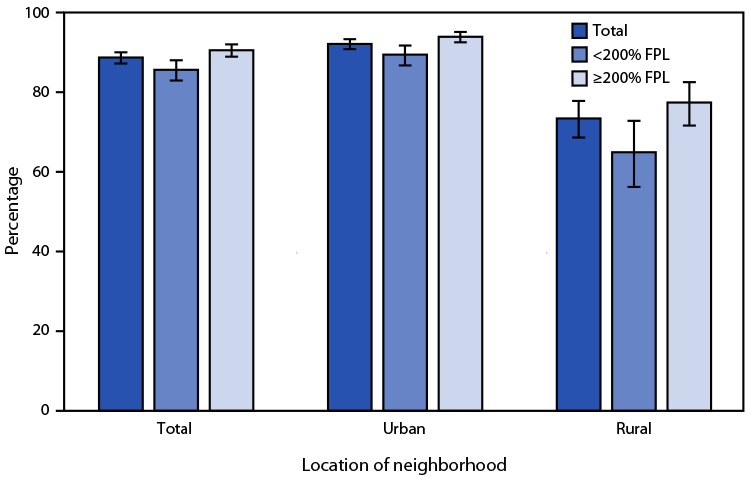QuickStats: Percentage* of Children and Adolescents Aged 6–17 Years Who Have Roads, Sidewalks, Paths, or Trails Where They Can Walk or Ride a Bicycle,† by Urban-Rural Status§ and Family Income¶ — National Health Interview Survey, United States, 2020**
Weekly / September 2, 2022 / 71(35);1136
Altmetric:

Abbreviations: FPL = federal poverty level; MSA = metropolitan statistical area.
* With 95% CIs indicated by error bars.
† Based on a positive response to the question, “Where the child lives, are there roads, sidewalks, paths or trails where they can walk or ride a bicycle?”
§ Urban-rural status is determined by the Office of Management and Budget’s February 2013 delineation of MSAs, in which each MSA must have at least one urban area of ≥50,000 inhabitants. Areas with <50,000 inhabitants are grouped into the rural category.
¶ As a percentage of FPL, which is based on family income and family size, using the U.S. Census Bureau’s poverty thresholds. Family income was imputed when missing.
** Estimates are based on household interviews of a sample of the civilian, noninstitutionalized U.S. population.
During 2020, 88.7% of children and adolescents aged 6–17 years had roads, sidewalks, paths, or trails in their neighborhood or near their home where they could walk or ride a bicycle. Availability of these spaces was less common among children and adolescents who lived in families with incomes <200% of FPL (85.6%) than among those in families with incomes ≥200% of FPL (90.5%) and was consistent among children and adolescents in both urban (89.4% versus 93.9%) and rural (64.9% versus 77.4%) areas. Regardless of income, availability of spaces to walk or ride a bicycle was lower among children and adolescents living in rural areas (73.4%) than among those in urban areas (92.1%).
Source: National Center for Health Statistics, National Health Interview Survey, 2020. https://www.cdc.gov/nchs/nhis/index.htm
Reported by: Amanda E. Ng, MPH, qkd2@cdc.gov, 301-458-4587; Dzifa Adjaye Gbewonyo, PhD.
Suggested citation for this article: QuickStats: Percentage of Children and Adolescents Aged 6–17 Years Who Have Roads, Sidewalks, Paths, or Trails Where They Can Walk or Ride a Bicycle, by Urban-Rural Status and Family Income — National Health Interview Survey, United States, 2020. MMWR Morb Mortal Wkly Rep 2022;71:1136. DOI: http://dx.doi.org/10.15585/mmwr.mm7135a5.
MMWR and Morbidity and Mortality Weekly Report are service marks of the U.S. Department of Health and Human Services.
Use of trade names and commercial sources is for identification only and does not imply endorsement by the U.S. Department of
Health and Human Services.
References to non-CDC sites on the Internet are
provided as a service to MMWR readers and do not constitute or imply
endorsement of these organizations or their programs by CDC or the U.S.
Department of Health and Human Services. CDC is not responsible for the content
of pages found at these sites. URL addresses listed in MMWR were current as of
the date of publication.
All HTML versions of MMWR articles are generated from final proofs through an automated process. This conversion might result in character translation or format errors in the HTML version. Users are referred to the electronic PDF version (https://www.cdc.gov/mmwr) and/or the original MMWR paper copy for printable versions of official text, figures, and tables.
Questions or messages regarding errors in formatting should be addressed to mmwrq@cdc.gov.